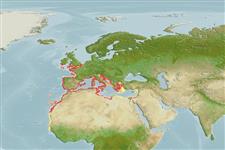>
Blenniiformes (Blennies) >
Tripterygiidae (Triplefin blennies) > Tripterygiinae
Etymology: Tripterygion: Greek, tres tria = three + Greek, pteron = wing, fin; diminutive (Ref. 45335).
Environment: milieu / climate zone / depth range / distribution range
البيئة
بحري القاع; نطاق العمق 0 - 40 m (Ref. 4785), usually 6 - 12 m (Ref. 4785). Subtropical; 52°N - 12°N, 19°W - 36°E
Eastern Atlantic and Mediterranean Sea: English Channel southwards and along the coast of west Africa, including Madeira and the Canary Islands (Ref. 4785), south to Senegal.
الحجم / وزن / العمر
Maturity: Lm ? range ? - ? cm
Max length : 8.9 cm TL ذكر/ مختلط الجنس; (Ref. 5294); common length : 6.0 cm TL ذكر/ مختلط الجنس; (Ref. 5294)
Adults inhabit shallow coastal waters with rocky substrate. They are found under overhanging rocks, entrances of caves and other biotopes with reduced light. In the Atlantic, they occur in shallow, light-exposed biotopes. They feed on benthic invertebrates, also on harpacticoids (Ref. 4785), amphipods and other copepods (Ref. 94105). Males court by figure-8-swimming (Ref. 4785). Eggs are hemispherical and covered with numerous sticky threads that anchor them in the algae on the nesting sites (Ref. 240). Larvae are planktonic which occur primarily in shallow, nearshore waters (Ref. 94114).
Life cycle and mating behavior
النضج | التكاثر | وضع البيض | بيض | الخصوبة | Larvae
Wirtz, P., 1990. Tripterygiidae. p. 916-917. In J.C. Quero, J.C. Hureau, C. Karrer, A. Post and L. Saldanha (eds.) Check-list of the fishes of the eastern tropical Atlantic (CLOFETA). JNICT, Lisbon; SEI, Paris; and UNESCO, Paris. Vol. 2. (Ref. 5294)
IUCN Red List Status (Ref. 130435)
استخدامات بشرية
حوض مائي: محتملة
مزيد من المعلومات
العمر/ الحجمنموالطول-الوزنالطول-الطولالطول- التردداتقياسات المظهر الخارجيالوصف الخارجيLarvaeحركة انتقال اليرقاتتوظيفالوفرةBRUVS
مراجعالأستزراع المائيملف الأستزراع المائيسلالاتجينيElectrophoresesالتوريثالأمراضمعالجةNutrientsMass conversion
المتعاونينصورStamps, Coins Misc.اصواتالتسمم باكل السمكسرعةنوع السباحةمنطقة الخياشيمعظمة الأذندماغرؤية
أدوات
تقارير خاصة
Download XML
مصادر علي الأنترنت
Estimates based on models
Preferred temperature (Ref.
123201): 12.5 - 21, mean 18.7 °C (based on 609 cells).
Phylogenetic diversity index (Ref.
82804): PD
50 = 0.5625 [Uniqueness, from 0.5 = low to 2.0 = high].
Bayesian length-weight: a=0.00562 (0.00258 - 0.01228), b=3.08 (2.89 - 3.27), in cm total length, based on LWR estimates for this (Sub)family-body shape (Ref.
93245).
مستوى غذائي (Ref.
69278): 3.4 ±0.44 se; based on food items.
المرونه (Ref.
120179): عالي, الحد الزمني الأدني لتضاعف عدد أفراد المجتمع أقل من 15 شهر (Preliminary K or Fecundity.).
Fishing Vulnerability (Ref.
59153): Low vulnerability (10 of 100).
Nutrients (Ref.
124155): Calcium = 360 [191, 886] mg/100g; Iron = 2.16 [1.12, 4.22] mg/100g; Protein = 18.4 [17.3, 19.5] %; Omega3 = 0.264 [0.123, 0.562] g/100g; Selenium = 30.7 [11.3, 72.4] μg/100g; VitaminA = 11.1 [2.9, 41.2] μg/100g; Zinc = 1.65 [1.01, 2.57] mg/100g (wet weight);
